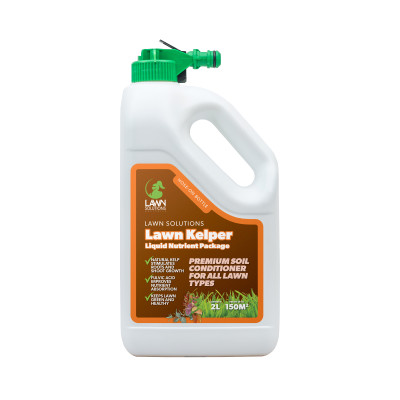Does your lawn not look its best, but not sure what’s causing it or how to get it back on track? In this blog, we take a look at how to diagnose common lawn problems and how to help get your lawn back in full health.
Skip to: What does grub damage look like? What does urine burn look like? What does a scalped lawn look like? What does a compacted lawn look like?
What Does Lawn Grub Damage Look Like?
Does your lawn have brown, dry damage that quickly spreads across your lawn? Lawn grubs and armyworms will eat away at the stem or grass roots, causing a distinguishable line of damage. Another common sign that your lawn may face grub or armyworm damage is increased black beetle or moth activity on or around the lawn. If you are concerned about grubs in your lawn, we recommend doing a grub test.
To do a grub test, mix up a bucket of water and add a few drops of dishwashing liquid. Then, pour this over the edge of the green grass and where the damage is. If there are grubs, they will rise up to the surface to breathe. This test is best done at dawn or dusk when the grubs are most likely to be active.
If you do find that there are grubs present, we recommend using a fast acting insecticide like Battle to get a quick knockdown of the damage-causing pests. Following this, we also recommend using a grub prevention product like our Grub Guard Ultimate.
For more information on how to help stop and prevent lawn grubs, please check out our blog here.

What Does Urine Burn Look Like?
Another common issue individuals may face with their lawn is urine burn. As dog’s urine can contain a concentrated amount of nitrogen, this can cause some burning and die-off on our lawns. When urine burns occur, the damage will be isolated to a small area and the patch will not spread like grub damage will.
There are a few methods you can try to help stop and reduce the impact of urine burns on your lawn. Please check out our blog for more information here.

What Does a Scalped Lawn Look Like?
Does your lawn get dry-looking patches after mowing, or does mowing your lawn remove all its green leaves? If the answer is yes, you might be scalping your lawn. Scalping can occur if:
– The lawn has grown too long in between mows.
– If the lawn levels are uneven.
– If there is an accumulation of thatch within the turf profile.

So, how can you stop scalping from occurring?
If your scalping is occurring from your lawn growing too long in between mows or if there is an accumulation of thatch, you will need to reset the height of your lawn. To do this, drop your mower height a few notches lower than your preferred mowing height – if there is an accumulation of thatch, you may need to go lower than this. Please note, when doing this to buffalo grass, you will need to ensure the above-ground runners are still present. After this, the lawn won’t look its best, but this will allow the new green leaf to grow back in at a lower height, so it’s not all removed when mowing. On your next mow, raise your mower back up to its normal mowing height and continue to mow regularly.
*Please note, it is best to only do this throughout the warmer months while your lawn is actively growing and should be avoided in winter.
If scalping has occurred due to uneven levels in your lawn, we recommend top dressing with washed or screened sand. For more information on how to top-dress your lawn, please check out our blog here.
What Does a Compacted Lawn Look Like?
Compacted soils will usually occur if there are high amounts of traffic on a lawn, or if there is a high amount of clay in the soil profile. Some tell-tale signs that you may have a compacted lawn include water pooling at the surface, thinning of grass, shallow roots and slow growth.
An easy way to tell if your lawn is compacted is to test and see if a screwdriver can easily be inserted into the soil. If the soil is compacted this will be difficult to do.
For aerating your lawn, we recommend using either a sturdy garden fork or a core aerator. To aerate, simply drive the fork into the profile and give it a good wiggle to help decompact the soil base. Following this, repeat this process across the lawn around 10cm apart. Alternatively, if you have a larger area to cover, you may want to hire a motorised aerator to help make this a quicker and easier task.
For more information on how to aerate your lawn, check out our blog here.

For more lawn care tips and advice make sure you check out our YouTube Channel or our other Lawn Care Blogs.


